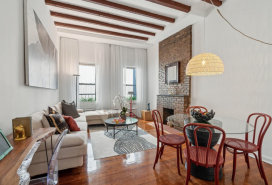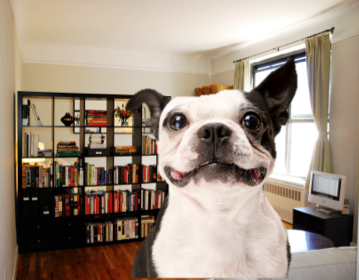9 questions you MUST ask before getting a dog in NYC

Several years ago, I brought an adorable puppy into my compact NYC life. Adopting Marshall, my Morkie (Maltese-Yorkshire Terrier), was not an easy decision, in large part because I work long hours and have an unpredictable schedule. I had hoped that my two roommates would help pitch in, but knew I couldn’t rely on them. This would be my responsibility—and it has been ever since.
I weighed the pros and cons—changing my schedule (con) versus having the love of a pup to come home to (pro) versus spending my savings on a fluffy ball of joy (both)—I decided it was the right time and adopted the cutest little guy in the world.
I imagined him adjusting to the situation a bit faster than he did, and didn’t realize just how quickly the costs would add up. He started out in a small cage, but I figured if he had access to a potty pad, food, water, and toys all day, he’d be fine. Then I realized that he needed space to run around, and that took money (dog walking money, that is).
Would you believe sweet little Marshall learned to crawl out of this thing?
Marshall also outsmarted his playpen and learned to crawl out. I had to completely change my lifestyle to suit him (and often run home right after work to be with him). It took a little time, but I’ve learned to make the best of things for the both of us. Now that we're adjusted, I have no regrets, and I wouldn't change a thing.
Here are 9 things to think about before getting a pup in NYC, plus some tips to make life easier if you do.
1. How big is too big?
Size matters, but maybe not as much as you think. Though it would seem to make sense to get a smaller dog for a smaller space, sometimes a big dog can do just fine in a smaller space, too.
In other words, says Christopher Turi, owner of Bark Ave Dog Walkers on the Upper East Side, size only matters sometimes.
“When I first moved to the city and saw great danes and mastiffs living here, I was under the assumption that the people who owned the dog must have a large living space,” he admitted. “After walking a few 100 pound-plus dogs, I discovered they turned out to be fairly tranquil, thus even a small living space was perfectly acceptable for them.”
2. Do you have time for a dog?
Dogs don’t like to sit still and nap in the sunlight like cats. They like to run around, play, and relieve themselves.
While it’s great to come home to a dog, remember that he or she will be alone all day if you have a 9 to 5 job at an office, and even longer if you work nights or have an erratic or long schedule and/or hectic social life (which is probably why you moved to NYC in the first place).
When I first got Marshall, I took a week to work from home and then slowly had to move him from a crate to a playpen to free reign over my room. (I had roommates in a medium-sized, three-bedroom apartment at the time.)
If you don’t have a significant other or someone to help out, consider whether it's fair for your new dog to be alone and cooped up all the time—especially if you have to work late often.
Turi notes that the main consideration you have to make before taking the plunge is the time you’re willing to sacrifice. Personal time is thrown out the window to make sure your dog enjoys the outdoors and exercises.
However, if you’re willing to fork up some cash (to the tune of at least $20 a day, usually per walk), you can hire a dog walker to make sure your pup can stretch his legs once or twice a day, and in turn won’t be unruly when you get home.
3. Which breed fits your lifestyle?
Some dogs adapt better to hanging out solo—and some don't. Corgis, for instance, are tiny and the subject of many Tumblr pages and GIF posts, but they’re herding dogs and want to run around; the same goes for Boston Terriers.
For a single person who works a lot, says Turi, a smaller breed like a Poodle, Yorkie, Shih Tzu, etc. makes more sense. (Side note: though they’re classified as “yappers,” all small dogs aren’t necessarily yippy.) Many single males opt for the English or French Bulldog, according to Turi.
No matter what the breed is, he says, “any type of puppy needs a lot of attention at the beginning, so be prepared to sacrifice a lot of time.” We promise it’s worth it.
(For a full list of compatible-with-New-York dog breeds, read here.)
4. How will you solve the bathroom problem?
Ideally, Turi says, a dog should be walked four times per day, preferably once in the morning, noon, afternoon/evening, and night. For older dogs, 15 minutes can be enough to relieve him or herself, but a younger dog needs “around 30-minute walks.”
Not everyone has time for that, and busy schedules as well as weather like snow, rain, and extreme heat or cold can keep you from going outside, so for small to medium dogs, potty pads—I use Pet Smart's Top Paw—are key. (Larger dogs make too much of a mess.)
Marshall on his first day in the apartment, in front of his Puppy Apartment
Training is relatively simple when you use potty pads, but takes patience. I got what was called a Puppy Apartment, which had one small side for a bed and the other for the pad. Marshall self-trained within a few days, and has had minimal accidents since.
If you don’t want to buy a special cage, you can spread out a bunch of pads on the floor—most have built-in attractant to make pups want to go on them, but you can also buy a spray—and slowly take one away as your dog gravitates toward one pad. Reward Fido with treats when he does his business where he's supposed to.
You can then gradually move the pad toward the door if you want your dog to go outside. Most dogs will inherently understand to go outside based on smells, but reward them when they go outdoors, too, just in enforce that it’s okay.
5. Is your building dog-friendly?
Before considering the dimensions of your place, you have to find out if a dog (or any pet, for that matter) is allowed in the building.
Some buildings that allow dogs have weight restrictions, typically stating “small dogs, up to 25 pounds,” and some prohibit breeds with aggressive reputations such as Rottweilers and Pitbulls (a list of banned dogs is often provided). Many limit the number of dogs you can have.
(Important note: Even if your current building accepts large dogs or commonly banned breeds, introducing one into your life will significantly cut down on your future housing options if you stay in NYC.)
6. How can you find a pet-friendly building?
One tried-and-true tactic is to hang around dog runs in the neighborhoods you're interested in and chat up other dog owners about dog-friendly buildings. (If you're looking for a rental, you might even score one without a broker's fee this way.)
Most real estate search sites also filter by pet-friendliness (this doesn't necessarily mean your pet will be allowed—dig futher for details). And if you're looking for a new apartment with a broker, make sure to let them know that you have a dog or are thinking of getting one, so they limit your search to pet-friendly buildings only.
Take a look at our list of the best NYC neighborhoods for dogs (we take into account things like proximity to dog runs).
7. Can you afford a dog?
In addition to any fees leveled by your building, dogs cost a lot of money. Even if you adopt or rescue and only pay a few fees upfront, there are vet costs—including necessary vaccinations, shots, medicine for fleas and ticks, and micro-chipping to keep tabs on your little guy—plus food, potty pads, a crate and/or carrier, bed, lots of toys, grooming and possibly a dog walker.
FYI, the puppy year tends to be the most expensive in terms of vet visits with shots and neutering. I spent $400 on the neuter alone, plus $95 per vet visit. Thankfully, Marshall came with most of his shots already done, but you can expect another few hundred for those, plus preventative medicines.
One of the most expensive parts of having a dog is grooming. Marshall's hair grows relatively quickly, so I have to get him groomed every two to three months; some groomers suggest as soon as every six to eight weeks! The lowest price I've found in Manhattan is $65 plus tip—which is more than I pay to get my hair cut—and have paid as much as $125 in a pinch.
The search for a groomer is fueled by Yelp and recommendations from friends, and one of my favorites is Paw Prints of Harlem, which offers daycare for the day for an additional $10 and has paw-motions on Mondays with discounted cuts. Keep in mind that most groomers only give you a 15-minute window to pick up your dog after their grooming is done (which typically takes two hours), so if daycare isn't offered, you'll have to leave work mid-day to drop off and pick up or schedule grooming on a weekend.
Also realize that owing to the close confines of vertical living—like, say, three trips a day in a teeny little elevator stuffed with friendly and not-so-friendly strangers—dog bites are actually one of the top three apartment insurance claims in NYC. According to apartment insurance broker Gotham Brokerage (a Brick sponsor), the average claim size is $10,000. Make sure your apartment is up to date and that your policy covers your breed of dog, as some aggressive breeds are commonly excluded from coverage.
A friendly neighbor with a friendly dog can be a major bonus. Emma, seen here with Marshall on his first birthday, plays with him, and her owner has even watched Marshall for extended periods of time.
8. What is the best dog-walking solution ?
Dog walkers aren’t cheap. Most charge between $20 and $30 for a 20-to-30-minute walk. I did a lot of research on Yelp and other sites before deciding to go with Bark Ave.
Questions to ask a potential dog walker include how many dogs will be walked at the same time, what sort of backup plan is in place if your dog walker can't make it, if they’ll provide references (and you can check if they have a good arsenal of reviews online), and how they will take care of your pup.
As for safety, you can ask your doorman to keep an eye on the walker—my building has a sign-out for guests using a spare key—or some businesses have tracking services via GPS. You can also install a doggie cam, but I just relied on word-of-mouth to trust Bark Ave.
Many places also have daytime "daycare" where you drop your pet off on the way to work for $20 to $40 per day, and overnight pet-sitting/boarding for $50 to $100 a night—yet another cost to consider before getting a pup.
I lucked out in that I found a neighbor who had a Morkie, too. Though her pup, Emma, is double Marshall’s size, they had fun together. Our pups were both lonely during the day, so it ended up being a win-win.
However, when I moved in March 2015, Marshall had to find a new friend. It took almost a year, but now he has steady playdates with a friend's dog, and we alternate at both of our apartments. I tried to get him some friends at training school, but found it's hard to convince strangers to have your dogs hang out. It could be easier if you take your dog to daily daycare and they make friends there, but that can get expensive quickly.
9. At the end of the day, can you make your dog happy?
It may sound like a silly question, but it’s the most important. Can you take care of a pup and make him or her happy?
Take your time deciding and make a list of pros and cons, but also just go with your heart. If you think you can make a pup happy, you probably can, and he or she will definitely return the favor, tenfold.
*** This article was first published on April 27, 2013. It was updated on March 31, 2016.





























